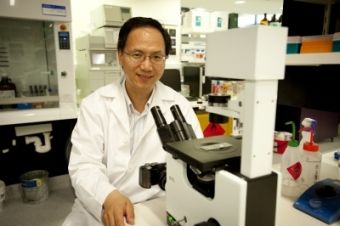
Publisher:
Bonnie King
CONTACT:
Newsroom@Salem-news.com
Advertising:
Adsales@Salem-news.com

~Truth~
~Justice~
~Peace~
TJP
Mar-01-2011 18:49

 TweetFollow @OregonNews
TweetFollow @OregonNews
Stem Cell Research Offers Hope for Cancer Cure
JD Adams Salem-News.comDeakin University is among the world's first institutions to exploit the possibilities offered by the latest revelations of the role stem cells play in the proliferation of cancers.
 Professor Wei Duan Laboratory of Nanomedicine at Deakin University in Australia. Courtesy: fastthinking.com |
(SALEM, Ore.) - At Deakin University in Melbourne, Australia, a conspicuous first has been achieved in the battle against cancer.
A technology leveraging stem cell research has been created which can target cancer in the body, using a chemical 'missile' known as an aptamer that has the inherent ability to deliver drugs to cancerous cells. Aptamers are macromolecules engineered to bind to specific target molecules.
Professor Wei Duan, the Director of the Nanomedicine Program at Deakin University, considers the aptamer approach to be a momentous advance in cancer treatment.
"Despite technological and medical advances, the survival rates for many cancers remain poor, due partly to the inability to detect cancer early and then provide targeted treatment."
"Current cancer treatments destroy the cells that form the bulk of the tumor, but are largely ineffective against the root of the cancer, the cancer stem cells. This suggests that in order to provide a cure for cancer we must accurately detect and eliminate the cancer stem cells."
While the medical possibilities of stem cells have been firmly imbued upon the public's awareness, the concept of cancer stem cells is on the cutting edge of medical research.
While the ramifications of cancer stem cells are still being debated in the scientific community, many scientists see CSCs as the Holy Grail of cancer treatments, and are forging ahead with techniques that may one day render current cancer treatments obsolete.
 A 'chemical missile' known as an aptamer is being |
Professor Duan explains that the aptamer breakthrough is the first step in a complete technique to annihilate cancer. "What we have created is the 'guided missile' part of the 'smart bomb'. The aptamer acts like a guided missile, targeting the tumor and binding to the root of the cancer."
"The aim now is to combine the aptamer with the 'bomb' (microscopic particle of fat) that can carry anti-cancer drugs or diagnostic imaging agents directly to the cancer stem cells, creating the ultimate medical smart bomb."
Russian histologist Alexander Maksimov first proposed the term stem cell in 1908, after observations leading to the conceptualization of cells that could differentiate to effect tissue repair. In 1960, Joseph Altman and Gopal Das submitted evidence supporting stem cell activity in the brain, which was initially ignored because it contradicted the existing dogma of 'no new neurons' in the brain.
Incremental progress was made with bone marrow transplants that contributed to the knowledge of the role that stem cells played. Moral concerns about human embryo research led to a 1973 moratorium on government funding, which was eventually overridden by Congress, but vetoed by President George Bush.
Later President Clinton lifted the ban on human embryo research, but public outrage by a vocal minority reinstated the ban. The controversy about stem cell research has created an erratic history that threatened to overshadow it's potential benefits.
The debate has largely been side-stepped by the development of induced pluripotent stem cells (iPSCs) that are 'adult stem cells' that have been recently found to exist in many of the tissues of the body, that have been reprogrammed to function like the embryonic stem cells.
Deakin University is among the world's first institutions to exploit the possibilities offered by the latest revelations of the role stem cells play in the proliferation of cancers. According to Dr, Duan, "The cancer stem cell-targeting missile and the smart bomb could revolutionize the way cancer is diagnosed. The minute size of the aptamer means it could locate cancer cells in their very early stages.
To best serve the research communities, Boster provides this special discounted custom antibody production service for researchers who use non-mammalian models such as Zebrafish, Drosophila, C. elegans and Yeast.
Attaching radioactive compounds to the aptamer could lead to the development of sensitive diagnostic scans for earlier detection, more accurate pinpointing of the location of cancer, better prediction of the chance of cure and improved monitoring of the response to treatment."
"More accurate identification of the type of cancer present would lead to more personalized treatment that is more successful and cost-effective. This could ultimately lead to better cancer survival rates and greatly improved quality of life for patients."
Like the stem cells which have been found in the tissues of adult humans, cancer stem cells have been found to possess qualities associated with the proliferation of the tissue in which they reside, in this case tumorigenic characteristics resulting in cancer growth, even with the application of conventional cancer therapies.
CSCs may cause growth of tumors by the processes of self-renewal and differentiation into various types of cells, and therefore are seen as a driving force for cancer relapse and metastasis.
The aptamer used by the Deakin Nanomedicine Program to target CSCs is the world's first RNA aptamer. It has been hypothesized that the first forms of life that existed employed RNA to encode genetic information rather than DNA, with some viruses still using RNA.
Sources:
http://stemcells.nih.gov/info/basics/
http://en.wikipedia.org/wiki/Stem_cell
http://en.wikipedia.org/wiki/Ribonucleic_acid
http://www.medicalnewstoday.com/articles/216916.php
http://www.npr.org/blogs/13.7/2011/02/07/133564047/treating-cancer-by-modifying-cancer-stem-cells
http://en.wikipedia.org/wiki/RNA_world_hypothesis
http://www.newsweek.com/2010/08/24/a-history-of-embryonic-stem-cell-research.html
___________________________________________
 J. D. Adams was born in Salem, Oregon, a descendant of Oregon Trail pioneer William Lysander Adams. As a wilderness explorer, photographer, and writer, he sustains a kinship with the spirit of the Oregon country. JD inhabits Oregon's Silicon Forest as an electronics professional with degrees in Electronics Engineering Technology and Microelectronics.
J. D. Adams was born in Salem, Oregon, a descendant of Oregon Trail pioneer William Lysander Adams. As a wilderness explorer, photographer, and writer, he sustains a kinship with the spirit of the Oregon country. JD inhabits Oregon's Silicon Forest as an electronics professional with degrees in Electronics Engineering Technology and Microelectronics.
He maintains a Web presence with a signature presentation in genres including travel, history, and technology.
You can write to Jim Adams at this email address: j1mcm0s@earthlink.net
Also, visit Jim's Website: home.earthlink.net/~j1mcm0s/
Articles for February 28, 2011 | Articles for March 1, 2011 | Articles for March 2, 2011
Quick Links
DINING
Willamette UniversityGoudy Commons Cafe
Dine on the Queen
Willamette Queen Sternwheeler
MUST SEE SALEM
Oregon Capitol ToursCapitol History Gateway
Willamette River Ride
Willamette Queen Sternwheeler
Historic Home Tours:
Deepwood Museum
The Bush House
Gaiety Hollow Garden
AUCTIONS - APPRAISALS
Auction Masters & AppraisalsCONSTRUCTION SERVICES
Roofing and ContractingSheridan, Ore.
ONLINE SHOPPING
Special Occasion DressesAdvertise with Salem-News
Contact:AdSales@Salem-News.com


Salem-News.com:


Terms of Service | Privacy Policy
All comments and messages are approved by people and self promotional links or unacceptable comments are denied.
Anonymous March 10, 2011 4:17 pm (Pacific time)
This is not the worlds first RNA aptamer get it straight.
[Return to Top]©2026 Salem-News.com. All opinions expressed in this article are those of the author and do not necessarily reflect those of Salem-News.com.